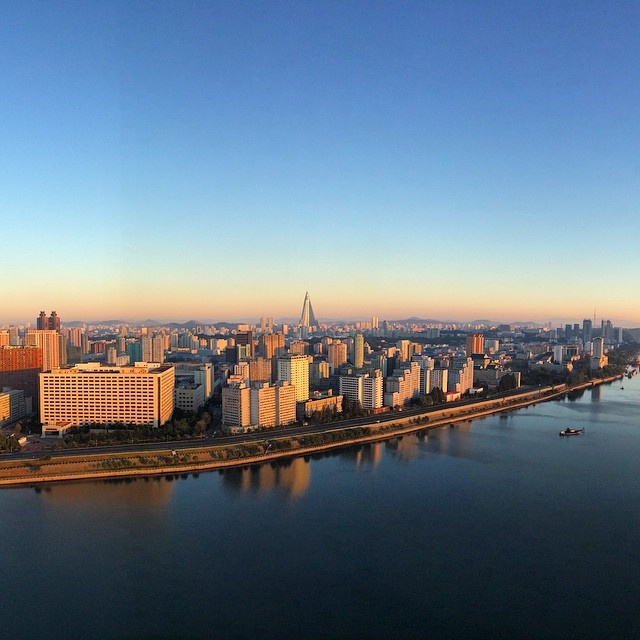Pyongyang (/ˈpjÉ'ŋˈjæŋ/; (ChosÅn'gÅl: í‰ì–'; hancha: 平壤), Korean pronunciation: [pÊ°jʌŋjaÅ‹], literally: "Flat Land" or "Peaceful Land", approved: P’yÅngyang; several variants) is the capital of the Democratic People's Republic of Korea (commonly known as North Korea) and the largest city in the country. Pyongyang is located on the Taedong River and, according to preliminary results from the 2008 population census, has a population of 3,255,388. The city was split from the South P'yÅngan province in 1946. It is administered as a directly governed city (chikhalsi, ì§í• ì‹œ) on the same level as provincial governments, not a special city (teukbyeolsi, 특별시) as Seoul in South Korea.
Names

"Pyongyang" literally means "Flat Land" in Korean. One of Pyongyang's many historic names is Ryugyong (류경; 柳京), or "capital of willows", as willow trees have always been numerous throughout the city's history; this served as an inspiration for many poems. Even today, the city has numerous willow trees, with many buildings and places having "RyugyÅng" in their names. The most notable of these is the uncompleted Ryugyong Hotel. The city's other historic names include Kisong, Hwangsong, Rakrang, SÅgyong, Sodo, Hogyong and Changan. During the early 20th century, Pyongyang came to be known among missionaries as being the "Jerusalem of the East", due to its historical status as a stronghold of Christianity, namely Protestantism.
After Kim Il-sung's death in 1994, some members of Kim Jong-il's faction proposed changing the name of Pyongyang to "Kim Il-sung City" (ê¹€ì¼ì„±ì‹œ), but others suggested that North Korea should begin calling Seoul as "Kim Il-sung City" instead and grant Pyongyang the moniker "Kim Jong-il City", and in the end neither proposal was implemented.
Prehistory

In 1955, archaeologists excavated evidence of prehistoric occupation in a large ancient village in the Pyongyang area, called KÅmtan-ni, dating to the ChÅlmun and Mumun pottery periods. North Koreans associate Pyongyang with "Asadal" (아사달), or WanggomsÅng (왕검성; 王儉城), the first second millennium BC capital of the Gojoseon kingdom according to Korean history books, notably Samguk Yusa. Many South Korean historians deny this claim because other Korean history books place Asadal around the Liao River located in western Manchuria. The connection between the two therefore may have been asserted by North Korea for the use of propaganda. Nevertheless, Pyongyang became a major city under Gojoseon.
History

It is likely that the area of Pyongyang belonged to Wiman Joseon, the longest-lasting part of Gojoseon, which fell in the Gojoseonâ€"Han War in 108 BC. Emperor Wu of the Han dynasty ordered four commanderies be set up, with Lelang Commandery in the center and its capital established as 平壤 (Old Chinese: *breÅ‹*naÅ‹Ê", modern Mandarin: pÃngrÇŽng, Korean: pyongyang). Several archaeological findings from the later, Eastern Han (25â€"220 AD) period in the Pyongyang area seems to suggest that Han forces later launched brief incursions around these parts.
The area around the city was called Nanglang during the early Three Kingdoms period. As the capital of Nanglang kingdom (ë‚™ëž'êµ), Pyongyang remained an important commercial and cultural outpost after Lelang Commandery was destroyed by an expanding Goguryeo in 313.
Goguryeo moved its capital there in 427. According to Christopher Beckwith, Pyongyang is the Sino-Korean reading of the name they gave it in their language: Piarna, or "level land".
In 668, Pyongyang became the capital of the Protectorate General to Pacify the East established by the Tang dynasty of China. However, by 676, it was taken by Silla, but left on the border between Silla and Balhae (Bohai). This lasted until the time of the Goryeo dynasty, when the city was revived as SÅgyÅng (Hangul: 서경; hanja: 西京; "Western Capital") although it was never actually a capital of the kingdom. It was the provincial capital of the Pyeongan Province during the Joseon dynasty.
In 1890, the city had 40,000 inhabitants. It was the site of an important battle during the First Sino-Japanese War, which led to the destruction and depopulation of much of the city. However, it was the provincial capital of South Pyeongan Province from 1896. Under colonial rule, the city became an industrial center, pronounced in Japanese as HeijÅ.
In July 1931 the city experienced Anti-Chinese riots as a result of the Wanpaoshan Incident and the sensationalized media reports of the incident which appeared in Japanese and Korean newspapers.
By 1938, Pyongyang had a population of 235,000.
Division of Korea and founding of DPRK
On 25 August 1945, the 25th army of the Soviet Army entered Pyongyang, and it became the temporary capital of the Provisional People's Committee for North Korea. It became the de facto capital of the Democratic People's Republic of Korea at its establishment in 1948. At that time, the Pyongyang government aimed to recapture Korea's official capital at that time, Seoul. Pyongyang was again severely damaged in the Korean War, during which it was briefly occupied by South Korean forces between 19 October 1950 and 6 December 1950. In 1952, it was the target of the largest aerial raid of the entire war, involving 1,400 UN aircraft.
After the Korean War
After the war, the city was quickly rebuilt with Soviet aid, with many buildings built in the style of Socialist Classicism.
The plans for the modern city of Pyongyang were first displayed for public viewing in a theatre building. On 27 July 1953 â€" the day the armistice between North Korea and South Korea was signed â€" The Pyongyang Review wrote: "While streets were in flames, an exhibition showing the general plan of restoration of Pyongyang was held at the Moranbong Underground Theater", the air raid shelter of the government under Moran hill. "On the way of victory... fireworks which streamed high into the night sky of the capital in a gun salute briefly illuminated the construction plan of the city which would rise soon with a new look".
In 2001 the authorities began a long-term modernization program. The Ministry of Capital City Construction Development was included in the cabinet in that year. In 2006, Kim Jong-il’s brother-in-law Jang Song-thaek took charge of the ministry.
Geography and climate

Pyongyang is in the west-central part of North Korea; the city lies on a flat plain about 50 kilometres (31Â mi) east of the Korea Bay, an arm of the Yellow Sea. The Taedong River flows southwestward through the city toward the Korea Bay.
Pyongyang has a humid continental climate (Köppen climate classification Dwa). Cold, dry winds can blow from Siberia in winter, making conditions very cold; the low temperature is usually below freezing between November and early March, although the average daytime high is at least a few degrees above freezing in every month except January. The winter is generally much drier than summer, with snow falling for 37 days on average.
The transition from the cold, dry winter to the warm, wet summer occurs rather quickly between April and early May, and there is a similar abrupt return to winter conditions in late October and November. Summers are generally hot and humid, with the East Asian monsoon taking place from June until August; these are also the hottest months, with average temperatures of 21 to 25 °C (70 to 77 °F), and daytime highs often above 30 °C (86 °F).
Politics

Major government and other public offices are located in Pyongyang. The seat of the Workers' Party Central Committee is located in Haenbangsan-dong, Chung-guyok. Pyongyang People's Committee is located in Haebangsan-dong, Chung-guyok. The Cabinet of North Korea is located in Jongro-dong, Chung-guyok.
The politics and management of the city is dominated by the Workers' Party of Korea, as they are in the national level. The city is managed by the Pyongyang Party Committee of the Workers' Party of Korea. The supreme standing legislative body is the Pyongyang People's Committee.
Administrative status and divisions
P'yÅngyang is divided into 18 wards (ku- or guyÅk) (the city proper) and 2 counties (kun or gun).
Foreign media reports in 2010 stated that Kangnam-gun, Chunghwa-gun, SangwÅn-gun, and SÅngho-guyÅk had been transferred to the administration of neighboring North Hwanghae province.
Culture

Landmarks
The capital has been completely redesigned since the Korean War (1950â€"53). It is designed with wide avenues, imposing monuments and monolithic buildings. The tallest structure in the city is the uncompleted 330-metre (1,080 ft) Ryugyong Hotel. This hotel has 105 floors and encloses 361,000 square metres (3,890,000 sq ft) of floor space. The original plan called for crowning it with seven revolving restaurants.
Notable landmarks in the city include:
- the Kumsusan Palace of the Sun
- the Arch of Triumph (heavily inspired by, but larger than, Paris's Arc de Triomphe)
- the reputed birthplace of Kim Il-sung at Mangyongdae Hill at the city outskirts
- Juche Tower
- two large stadiums:
- Rungnado May Day Stadium
- Kim Il-sung Stadium
- the Mansu Hill complex
- Kim Il-sung Square
- Yanggakdo International Hotel
- Korean Revolution Museum
Pyongyang TV Tower is a minor landmark. Other visitor attractions include the Korea Central Zoo. The Arch of Reunification has a map of a united Korea supported by two concrete Korean women dressed in traditional dress straddling the Reunification Highway, which stretches from Pyongyang to the Korean Demilitarized Zone (DMZ).
As of 2011 current construction includes a claimed 100,000 new homes in the city, including a large project along Changjeon Street. This is the top construction priority and uses KPA soldiers as labor. Supposedly construction plans began after Kim Jong-il described the area as "pitiful".
Cuisine
Pyongyang served as the provincial capital of Pyeongan province until 1946, and Pyongyang cuisine shares the general culinary tradition of the Pyeongan province. The most famous local food is Pyongyang naengmyeon, or also called mul naengmyeon or just simply naengmyeon. Naengmyeon literally means "cold noodles", while the affix mul refers to "water" because the dish is served in a cold broth. Naengmyeon consists of thin and chewy buckwheat noodles in a cold meat-broth with dongchimi (watery kimchi) and topped with a slice of sweet Korean pear. Pyongyang naengmyeon was originally eaten in homes built with ondol (traditional underfloor heating) during the cold winter, so it is also humorously called "Pyongyang deoldeori" (shivering in Pyongyang). Pyongyang locals sometimes enjoyed it as a haejangguk, which is any type of food eaten as a hangover-cure, usually a warm soup.
Another representative Pyongyang dish, Taedonggang sungeoguk, translates as "trout soup from the Taedong River". The soup features trout (abundant in the Taedong River) along with black peppercorns and salt. It is served as a courtesy to important guests visiting Pyongyang. Therefore, the question "How good was the trout soup?" is commonly used to greet people returning from Pyongyang. Another local specialty, Pyongyang onban (literally "warm rice of Pyongyang"), comprises freshly cooked rice topped with sliced mushrooms, chicken, and a couple of bindaetteok (pancakes made from ground mung beans and vegetables).
Famous restaurants in the city include Okryugwan and Ch'ongryugwan.
Sports

Pyongyang has a number of sports clubs, including the April 25 Sports Club and the Pyongyang City Sports Club. The most popular sport in Pyongyang is football.
Transportation
Domestic trains
Pyongyang railway station serves the main railway lines, including the Pyongui Line and the Pyongbu Line.
International trains
The city also has regular international rail services to Beijing and Moscow. A journey to Beijing takes about 25Â hours and 25Â minutes (K27 from Beijing/K28 from Pyongyang, on Mondays, Wednesdays, Thursdays and Saturdays); a journey to Moscow takes 6Â days. The city also connects to the Eurasian Land Bridge via the Trans-Siberian Railway.
Metro, tram and bus
The Pyongyang Metro is a two-line underground metro system which has a length of 22.5Â km (14.0Â mi). The Hyoksin line serves Kwangbok, Konguk, Hwanggumbol, Konsol, Hyoksin, Jonu, Jonsung, Samhung and Rakwon stations. The Chollima line serves Puhung, Yonggwang, Ponghwa, Sungni, Tongil, Kaeson, Jonu and Pulgunbyol stations.
There is also a 53Â km (33Â mi) long Pyongyang tram system and a 150Â km (93Â mi) Pyongyang trolleybus system. The trolley bus-stops are fairly busy.
Cars
There are few cars in the city, cars being a symbol of status in the country due to their scarcity as a result of restrictions on import because of international sanctions and domestic regulations. The scarcity of fuel makes the cost of using cars prohibitive. In addition, some roads are in poor condition.
Air
State-owned Air Koryo (ê³ ë ¤í•ê³µ, Koryo Hang-Gong) has scheduled flights from Pyongyang Sunan International Airport to Beijing (PEK), Shenyang (SHE), Vladivostok (VVO), Moscow (SVO), Bangkok (BKK), Khabarovsk (KHV), Kuala Lumpur (KUL), and Shanghai (PVG).
Air Koryo also operates limited scheduled service to a few domestic destinations. The only domestic destinations are Hamhung, Wonsan, Chongjin, Hyesan and Samjiyon. In April 2008, Air China launched a regular service between Beijing and Pyongyang.
Another airport, Mirim Airport, is located in the east of the city. It appears to have fallen into disuse.
Hotels
Pyongyang has two major operating hotels: the Yanggakdo International Hotel and the Koryo Hotel. The Ryugyong Hotel is the tallest building in North Korea but remains unopened. The Yanggakdo Hotel is the second tallest. The Yanggakdo, Koryo and Ryugyong hotels are designed to cater to foreign tourists. Other hotels include the: Taedonggang Hotel, Ryanggang Hotel, Moranbong Hotel, Haebangsan Hotel, and Sosan Hotel.
Retail
Pyongyang is home to several large department stores including: Pyongyang Department Store No. 1, Pyongyang Department Store No. 2, Kwangbok Department Store, Ragwon Department Store, Pyongyang Station Department Store and the Pyongyang Children’s Department Store.
Gallery
Twin towns â€" Sister cities
Pyongyang is twinned with:
- Kathmandu, Nepal
- Kuala Lumpur, Malaysia
- Moscow, Russia
- Singapore
- Tianjin, China
- Baghdad, Iraq
- Georgetown, Guyana
See also
- List of cities in North Korea
Notes
References
Further reading
- Kracht, Christian, Eva Munz & Lukas Nikol. The Ministry of Truth: Kim Jong Il's North Korea. Feral House, October 2007. ISBN 978-1-93259527-7.
- Springer, Chris. Pyongyang: The Hidden History of the North Korean Capital. Saranda Books, 2003. ISBN 963-00-8104-0.
- Willoughby, Robert. North Korea: The Bradt Travel Guide. Globe Pequot, 2003. ISBN 1-84162-074-2.
- Dormels, Rainer. North Korea's Cities: Industrial facilities, internal structures and typification. Jimoondang, 2014. ISBN 978-89-6297-167-5
External links
- interactive virtual tour Aerial view of Pyongyang city
- Super High Resolution Image Panoramic view of Pyongyang city
- 22 minute video of bus ride through Pyongyang, DPRK on YouTube
- North Korea Uncovered, (North Korea Google Earth), a comprehensive mapping of North Korea, including all of the locations mentioned above, on Google Earth
- Holidays in Pyongyang
- Instagram photos of Pyongyang
- City profile of Pyongyang
- Pyongyang at night
- Pyongyang at Night! on YouTube
- Pyongyang at Night on 15 April 2012 on YouTube
- Pyongyang at Night on YouTube
- Pyongyang at Night River View DPRK on YouTube

Posting Komentar